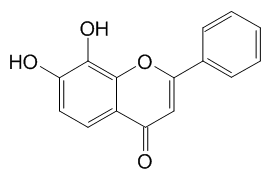ATC code None PubChem CID 1880 ECHA InfoCard 100.048.903 Formula C15H10O4 | CAS Number 38183-03-8 ChemSpider 1809 3D model (Jmol) Interactive image Molar mass 254.238 g/mol | |
 | ||
7,8-Dihydroxyflavone (7,8-DHF) is a naturally occurring flavone found in Godmania aesculifolia, Tridax procumbens, and primula tree leaves. It has been found to act as a potent and selective small-molecule agonist of the TrkB receptor (Kd ≈ 320 nM), the main signaling receptor of brain-derived neurotrophic factor (BDNF). 7,8-DHF is both orally-bioavailable and able to penetrate the blood-brain-barrier.
7,8-DHF has demonstrated remarkable therapeutic efficacy in animal models of a variety of central nervous system disorders, including depression, Alzheimer's disease, cognitive deficits in schizophrenia, Parkinson's disease, Huntington's disease, amyotrophic lateral sclerosis, traumatic brain injury, cerebral ischemia, fragile X syndrome, and Rett syndrome. 7,8-DHF also shows efficacy in animal models of age-associated cognitive impairment and enhances memory consolidation and emotional learning in healthy rodents. In addition, 7,8-DHF possesses powerful antioxidant activity independent of its actions on the TrkB receptor, and protects against glutamate-induced excitotoxicity, 6-hydroxydopamine-induced dopaminergic neurotoxicity, and oxidative stress-induced genotoxicity. It was also found to block methamphetamine-induced dopaminergic neurotoxicity, an effect which, in contrast to the preceding, was found to be TrkB-dependent.
7,8-DHF has been found to act as a weak aromatase inhibitor in vitro (Ki = 10 μM), though there is evidence to suggest that this might not be the case in vivo. In addition, it has been found to inhibit aldehyde dehydrogenase and estrogen sulfotransferase in vitro (Ki = 35 μM and 1–3 μM, respectively), though similarly to the case of aromatase, these activities have not been confirmed in vivo. Unlike many other flavonoids, 7,8-DHF does not show any inhibitory activity on 17β-hydroxysteroid dehydrogenase. 7,8-DHF has also been observed to possess in vitro antiestrogenic effects at very high concentrations (Ki = 50 μM).
A variety of close structural analogs of 7,8-DHF have also been found to act as TrkB agonists in vitro, including diosmetin (5,7,3'-trihydroxy-4'-methoxyflavone), norwogonin (5,7,8-trihydroxyflavone), 4'-dimethylamino-7,8-dihydroxyflavone, 7,8,3'-trihydroxyflavone, 7,3'-dihydroxyflavone, 7,8,2'-trihydroxyflavone, 3,7,8,2'-tetrahydroxyflavone, and 3,7-dihydroxyflavone. The highly hydroxylated gossypetin (3,5,7,8,3',4'-hexahydroxyflavone), conversely, appears to be an antagonist of TrkB in vitro.
A prodrug of 7,8-DHF, R7, is under development for the treatment of Alzheimer's disease.
